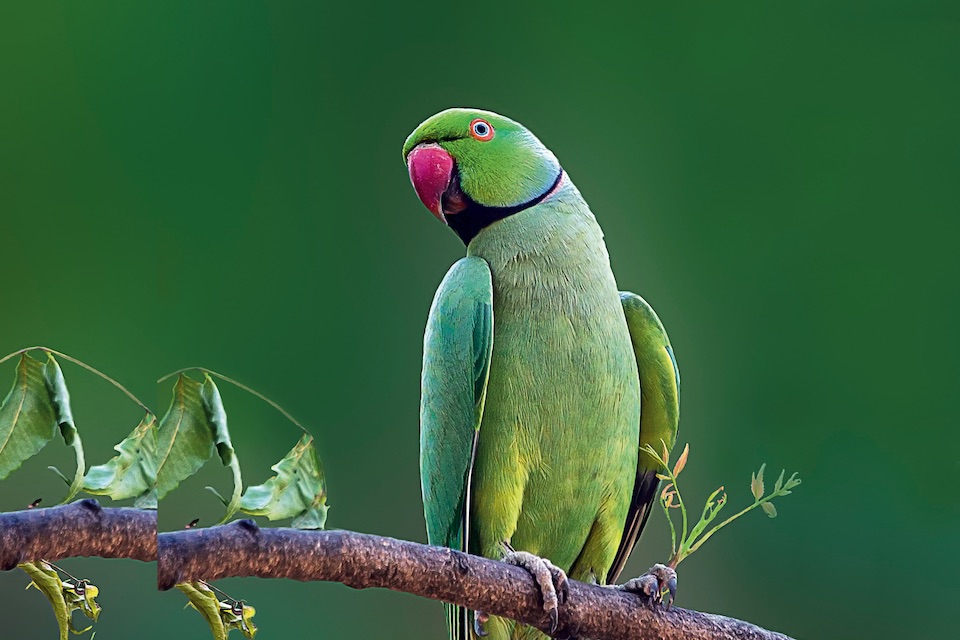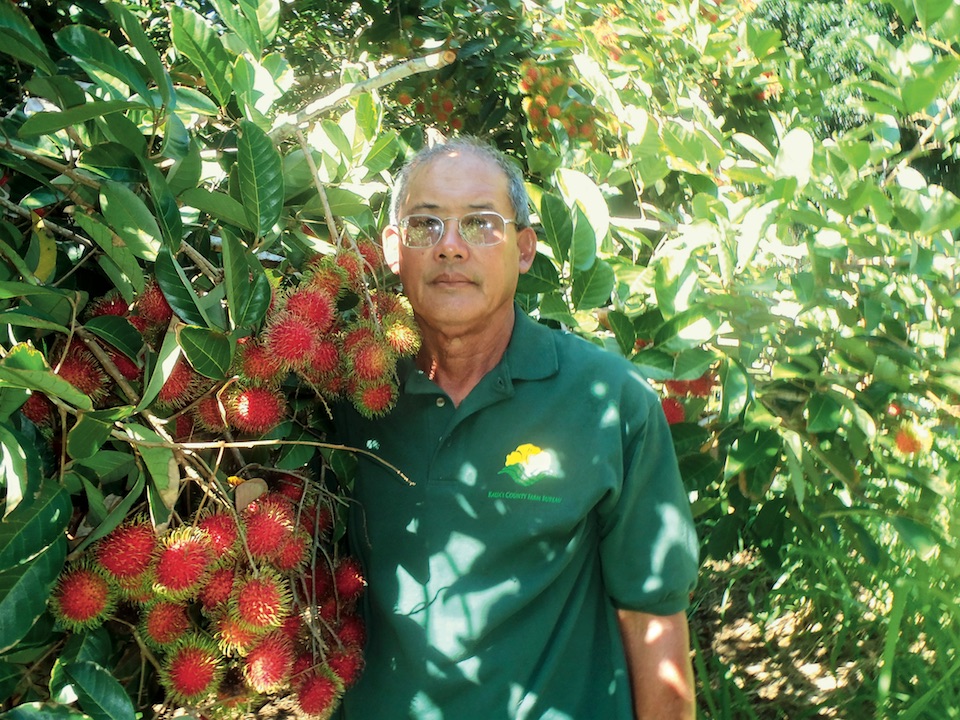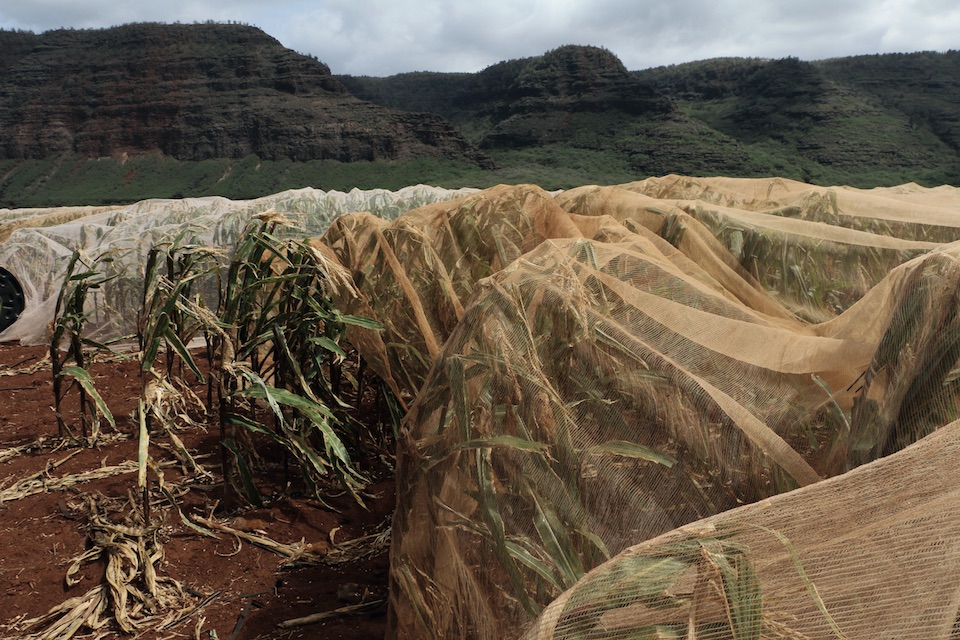Invasive Parakeets Are Threatening Every Crop on the Hawaiian Island of Kauai”and Multiplying Fast
The rose-ringed parakeet was once a pampered pet. Now it’s a plague.
Invasive Parakeets Are Threatening Every Crop on the Hawaiian Island of Kauai”and Multiplying Fast
The rose-ringed parakeet was once a pampered pet. Now it’s a plague.

Roland Goo first noticed the green fog six years ago, as it rolled over his 20-acre orchard on the Hawaiian island of Kauai. Suddenly, amid a deafening chirping chorus, the cloud dispersed into hundreds of birds that descended upon the farmer’s lychee grove, rapidly denuding an entire 60-foot-tall tree. These rose-ringed parakeets (so named for a subtle pink stripe around male birds’ necks) have since become frequent visitors to Goo’s Kilakila Gardens, where the pests figured out that his rambutan crop turns crimson when ripe. “They’ll fly 200 feet above my fields looking for red fruit before diving down to eat,” says the 66-year-old. Only his mangoes, too large for little bird beaks, remain relatively unscathed.
Goo patrols the property each morning with a shotgun. Despite killing several hundred parakeets a year, he estimates his annual losses at 15 percent, or $5,000. He knows he’ll never completely eradicate the problem but hopes to send the birds a message. “They’re really smart,” Goo explains. “They’ll dispatch a few members of the flock to case a farm. Once they establish that it’s a good place to feed, they’ll eat everything. Everything.”
Like Goo, Jerry Ornellas operates an orchard in southeastern Kauai, an area hit particularly hard by parakeets. Ornellas, who represents the island on the state Board of Agriculture, reports losing 30 percent of his breadfruit, longan, and lychee crops in 2016. “It depends on where you are geographically,” he says, “but small farms are averaging a 10 percent loss.” To put that figure in perspective: Agriculture generates almost $65 million in annual revenue for Kauai, making the industry the island’s third-largest behind tourism and government.

Rose-ringed parakeets haven’t always been Public Enemy No. 1. It wasn’t until the 1960s that the tropical species – native to sub-Saharan Africa and South Asia – gained traction as a house pet in the developed world. On Kauai, the birds initially went wild in 1968, after workers at a bed-and-breakfast accidentally released a pair. Those two eventually attracted others, including escapees from homes destroyed by 1982’s Hurricane Iwa. Their numbers swelled from fewer than 200 in the mid-1990s to approximately 1,000 by the dawn of the new millennium, and today hover around 5,000. That growth curve will only steepen, given the parakeets’ rapid reproduction rate and 20- to 30-year lifespan, coupled with the island’s hospitable climate and ample food. According to Thomas Kaiakapu, Kauai wildlife manager at the Hawaii Department of Land and Natural Resources: “Left unchecked, the population could reach 10,000 in the next five years.”
Globally, the rose-ringed parakeet has spread to 35 countries beyond its native habitats – few as adversely affected as Israel, where up to 50,000 birds devour wine grapes, dates, sunflower seeds, and nearly half the yearly almond harvest. “They’re among the worst alien species,” says Yariv Malihi, an ecologist with the Israel Nature and Parks Authority. And while Kauai’s parakeet population is much smaller, so is its land mass. Already, the tiny island claims roughly 40 percent more birds per square mile than Israel, and by far the highest concentration in the world.
How did the situation spiral out of control? “Rose-ringed parakeets are slow invaders. They aren’t noticed until their numbers reach a critical mass,” explains Aaron Shiels, a biologist at the National Wildlife Research Center, adding that agriculture isn’t the only part of the Kauai economy affected. The birds’ chalky droppings and piercing chirps annoy tourists, spurring the removal of majestic royal palms (read: ideal roosts) in popular vacation destinations. Shiels and other conservationists warn that the parakeets could soon wreak havoc on the island’s protected rain forests, competing for resources with endangered native birds and spreading seed from invasive plants, eventually pushing delicate ecosystems to the brink.
Kauai is an island of small farms. Nearly 85 percent of its agricultural outfits – largely situated on the lush southeast side – span fewer than 50 acres. The rose-ringed parakeet, however, recently expanded its purview to encompass the drier western shore, where Monsanto, Dow, and Syngenta (which sold its operation to Wisconsin-based Hartung Brothers in June) have long maintained a combined 16,000 or so acres of test fields. “We lost two acres of corn in a single weekend late last summer,” relays Dow spokesman David Sousa. For these huge corporations, says Shiels, “Bird-management techniques can run hundreds of thousands of dollars a year in Kauai alone.”

It was enough to convince the multinational giants to play nice with the locals, following a protracted legal battle over a county ordinance limiting pesticide use and GMO experimentation. Big Ag and Kauai’s indie farmers formed an unlikely alliance, jointly lobbying for state legislation intended to control the island’s rose-ringed parakeet problem. Explains Joshua Uyehara: “I’m employed by Hartung Brothers, but my dad is a small lychee grower. This is a tight-knit community. We’ll work together to address our shared concerns.”
A bill, passed in June 2017, ear-marks $75,000 for scientific studies but has yet to generate consensus around a solution. Short-term options, such as covering fields in netting and deploying faux-falcon robots, invite questions about cost. Mass sterilization via chemically treated feed raises legitimate environmental concerns. Goo’s preferred method – shotgun plus shells – has proven effective in the Seychelles. A UNESCO-sponsored eradication program there asserts that the 115-island archipelago will be free of the birds by the end of 2017.
“If a mass kill-off is ordered, we’ll fight it,” declares Cathy Goeggel, president of Animal Rights Hawaii. “It would be cruel and inappropriate.” Goeggel cites previous efforts to rid the Big Island of invasive coqui frogs in the late 1990s. “They wrecked Lava Tree State Park trying to poison those frogs,” she says. “And still, the frogs came back.”
Other critics complain that the bill doesn’t allocate enough funds for research efforts, much less put a timeline on the studies or any resulting actions. Paul Huber, who tends rambutans, papayas, pineapples, longans, and avocados on 38 north-eastern Kauai acres, has seen a few parakeets, anticipates more, and refuses to countenance the non-chalance of government officials. “They’ve done nothing to fix the situation, and farmers are paying the price,” says Huber, 65. He cut numerousmature ironwood trees, which protected his crops from the strong trade winds, to half their height, in an effort to deter roosting and render the birds easier targets. Huber doesn’t relish using his shotgun and would rather take aim at the underlying issue: invasive species. “We shouldn’t be so blasé about animals that don’t belong here,” he says. “They change the whole environment. This dilemma’s indicative of a larger problem.”
SaveSave
SaveSave
SaveSaveSaveSave
SaveSave
SaveSave
SaveSave
Follow us

This work is licensed under a Creative Commons Attribution-NoDerivatives 4.0 International License.
Want to republish a Modern Farmer story?
We are happy for Modern Farmer stories to be shared, and encourage you to republish our articles for your audience. When doing so, we ask that you follow these guidelines:
Please credit us and our writers
For the author byline, please use “Author Name, Modern Farmer.” At the top of our stories, if on the web, please include this text and link: “This story was originally published by Modern Farmer.”
Please make sure to include a link back to either our home page or the article URL.
At the bottom of the story, please include the following text:
“Modern Farmer is a nonprofit initiative dedicated to raising awareness and catalyzing action at the intersection of food, agriculture, and society. Read more at <link>Modern Farmer</link>.”
Use our widget
We’d like to be able to track our stories, so we ask that if you republish our content, you do so using our widget (located on the left hand side of the article). The HTML code has a built-in tracker that tells us the data and domain where the story was published, as well as view counts.
Check the image requirements
It’s your responsibility to confirm you're licensed to republish images in our articles. Some images, such as those from commercial providers, don't allow their images to be republished without permission or payment. Copyright terms are generally listed in the image caption and attribution. You are welcome to omit our images or substitute with your own. Charts and interactive graphics follow the same rules.
Don’t change too much. Or, ask us first.
Articles must be republished in their entirety. It’s okay to change references to time (“today” to “yesterday”) or location (“Iowa City, IA” to “here”). But please keep everything else the same.
If you feel strongly that a more material edit needs to be made, get in touch with us at [email protected]. We’re happy to discuss it with the original author, but we must have prior approval for changes before publication.
Special cases
Extracts. You may run the first few lines or paragraphs of the article and then say: “Read the full article at Modern Farmer” with a link back to the original article.
Quotes. You may quote authors provided you include a link back to the article URL.
Translations. These require writer approval. To inquire about translation of a Modern Farmer article, contact us at [email protected]
Signed consent / copyright release forms. These are not required, provided you are following these guidelines.
Print. Articles can be republished in print under these same rules, with the exception that you do not need to include the links.
Tag us
When sharing the story on social media, please tag us using the following: - Twitter (@ModFarm) - Facebook (@ModernFarmerMedia) - Instagram (@modfarm)
Use our content respectfully
Modern Farmer is a nonprofit and as such we share our content for free and in good faith in order to reach new audiences. Respectfully,
No selling ads against our stories. It’s okay to put our stories on pages with ads.
Don’t republish our material wholesale, or automatically; you need to select stories to be republished individually.
You have no rights to sell, license, syndicate, or otherwise represent yourself as the authorized owner of our material to any third parties. This means that you cannot actively publish or submit our work for syndication to third party platforms or apps like Apple News or Google News. We understand that publishers cannot fully control when certain third parties automatically summarize or crawl content from publishers’ own sites.
Keep in touch
We want to hear from you if you love Modern Farmer content, have a collaboration idea, or anything else to share. As a nonprofit outlet, we work in service of our community and are always open to comments, feedback, and ideas. Contact us at [email protected].by Sara Novak, Modern Farmer
January 22, 2018
Modern Farmer Weekly
Solutions Hub
Innovations, ideas and inspiration. Actionable solutions for a resilient food system.
ExploreExplore other topics
Share With Us
We want to hear from Modern Farmer readers who have thoughtful commentary, actionable solutions, or helpful ideas to share.
SubmitNecessary cookies are absolutely essential for the website to function properly. This category only includes cookies that ensures basic functionalities and security features of the website. These cookies do not store any personal information.
Any cookies that may not be particularly necessary for the website to function and are used specifically to collect user personal data via analytics, ads, other embedded contents are termed as non-necessary cookies.
There must be a non chemical solution used immediately. Cruel, maybe but life is not fare. It has taken far too long for action. It is cruel to the farmers to take their livelihood and they have a very important job, making real food for the planet. Is it not cruel to poison us all, take away our food and the farmers livelihood? We can send man to the moon. Surely we can figure out a way to save and protect the most precious commodity on earth.
I agree with Paul Huber.. invasive species problem is a root cause of much environmental damage.. This really needs to be addressed right away